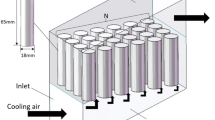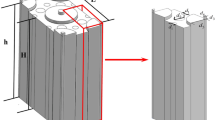Abstract
Battery thermal management system (BTMS) is essential to the safe operation of electric vehicles. In order to improve the heat dissipation performance of BTMS, the Non-dominated sorting genetic algorithm-2 (NSGA2) combined with neural network is used to optimize the battery pack with multiple objectives. First, the three-dimensional battery pack model is converted into the two-dimensional model to simulate 2000 battery packs, saving much calculation time. Subsequently, five parameters, including the width of the inlet and the outlet, the position of the inlet and the outlet, and the battery spacing, are used as design variables to establish a BP neural network model with a good prediction effect of BTMS. After that, the NSGA2 algorithm is used to optimize the neural network model with multiple objectives. Finally, the final design solution with the lowest maximum temperature in the Pareto solution set is selected and simulated. The results show that the maximum temperature of the optimized battery pack is reduced by 7.5 K, the maximum temperature difference is reduced by 67.4%, and the power consumption is reduced by 26%.
















Similar content being viewed by others
Data Availability
The data that support the findings of this study are available from the corresponding author upon reasonable request.
Abbreviations
- \({C}_{u}\) :
-
Parameter of the turbulence model
- \(\Delta T\) :
-
Maximum temperature difference (K)
- Tmax :
-
Maximum temperature (K)
- Q0:
-
Inlet air flow rate (m3/s)
- \(d\) :
-
Battery spacing (mm)
- \({J}_{\text{wi}}\) :
-
Outlet width (mm)
- \({I}_{\text{wi}}\),:
-
Inlet width (mm)
- \({I}_{po}\) :
-
Inlet position (mm)
- \({J}_{po}\) :
-
Outlet position (mm)
- \(k\) :
-
Turbulent kinetic energy
- \(p\) :
-
Reynolds-averaged pressure (Pa)
- \({c}_{p}\) :
-
Heat capacity of the air (J/(kg·K))
- \({\phi }_{b}\) :
-
Heat generation rate of the battery (W)
- \(\rho\) :
-
Densities of the air and (kg/m3)
- \({\rho }_{b}\) :
-
Densities of the battery cell (kg/m3)
- \(\lambda\) :
-
Thermal conductivity of the air
- \({\lambda }_{b}\) :
-
Thermal conductivity of the battery (W/(m·K))
- \(\varepsilon\) :
-
Dissipation rate of the turbulent kinetic energy
- \(\mu\) :
-
Molecular dynamic viscosity coefficient
- \({\mu }_{t}\) :
-
Turbulent dynamic viscosity coefficient
- \({\sigma }_{k}\), \({\sigma }_{\varepsilon }\) \({\sigma }_{T}\) :
-
Parameters of the \(k-\varepsilon\) turbulence model
- max:
-
Maximum
- wi:
-
Width
- po:
-
Position
- b:
-
Battery
References
Williford RE, Viswanathan VV, Zhang JG (2009) Effects of entropy changes in anodes and cathodes on the thermal behavior of lithium ion batteries. J Power Sources 189:101–107
Tamura K, Horiba T (1999) Large-scale development of lithium batteries for electric vehicles and electric power storage applications. J Power Sources 81:156–161
Onda K, Ohshima T, Nakayama M et al (2006) Thermal behavior of small lithium-ion battery during rapid charge and discharge cycles. J Power Sources 158:535–542
Pesaran AA (2002) Battery thermal models for hybrid vehicle simulations. J Power Sources 110:377–382
Hou J et al (2022) A direct optimization strategy based on field synergy equation for efficient design of battery thermal management system. Int J Heat Mass Transfer 184:122304
Lan X et al (2022) Design and optimization of a novel reverse layered air-cooling battery management system using U and Z type flow patterns. Int J Energy Res 46.10:14206–14226
Zhang J et al (2021) Experimental and numerical studies on an efficient transient heat transfer model for air-cooled battery thermal management systems. J Power Sources 490:229539
Liao X et al (2019) Temperature distribution optimization of an air-cooling lithium-ion battery pack in electric vehicles based on the response surface method. J Electrochem Energy Convers Storage 16.4:041002
Chen K, Chen Y, Song M et al (2020) Multi‐parameter structure design of parallel mini‐channel cold plate for battery thermal management[J]. Int J Energy Res.
Qian Z, Li Y, Rao Z (2016) Thermal performance of lithium-ion battery thermal management system by using mini-channel cooling. Energy Convers Manage 126:622–631
Li S et al (2021) Flexible phase change materials obtained from a simple solvent-evaporation method for battery thermal management. J Energy Storage 44:103447
Wu W et al (2022) Composite phase change material with room-temperature-flexibility for battery thermal management. Chem Eng J 428:131116
Ye G et al (2022) Temperature control of battery modules through composite phase change materials with dual operating temperature regions. Chem Eng J 449:137733
Alipanah M, Li X (2016) Numerical studies of lithium-ion battery thermal management systems using phase change materials and metal foams. Int J Heat Mass Trandf 102:1159–1168
Jiang ZY, Qu ZG (2019) Lithium–ion battery thermal management using heat pipe and phase change material during discharge–charge cycle: a comprehensive numerical study. Appl Energ 242:378–392
Pesaran AA (2001) Battery thermal management in EVEs and HEVs:Issues and solutions. Nevada,Advanced Automotive Battery Conference.
Pesaran AA, Burch S, Keyser M (1999) An approach for designing thermal management systems for electric and hybrid vehicle battery packs.London,Fourth Vehicle Thermal Management Systems Conference and Exhibition.
Lyu C et al (2021) A new structure optimization method for forced air-cooling system based on the simplified multi-physics model. Appl Therm Eng 198:117455
Wang T, Tseng KJ, Zhao J et al (2014) Thermal investigation of lithium-ion battery module with different cell arrangement structures and forced air-cooling strategies [J]. Appl Energy 134:229–238
Xun J, Liu R, Jiao K (2013) Numerical and analytical modeling of lithium ion battery thermal behaviors with different cooling designs [J]. J Power Sources 233:47–61
He F, Li X, Ma L (2014) Combined experimental and numerical study of thermal management of battery module consisting of multiple Li-ion cells [J]. Int J Heat Mass Transf 72:622–629
Severino B, Gana F, Palma-Behnke R et al (2014) Multi-objective optimal design of lithium-ion battery packs based on evolutionary algorithms [J]. J Power Sources 267:288–299
Chen K, Wang S, Song M et al (2017) Configuration optimization of battery pack in parallel air-cooled battery thermal management system using an optimization strategy [J]. Appl Therm Eng 123:177–186
Chen J et al (2021) Multiobjective optimization of air-cooled battery thermal management system based on heat dissipation model. Ionics 27:1307–1322
Chen K, Wu W, Yuan F et al (2019) Cooling efficiency improvement of air-cooled battery thermal management system through designing the flow pattern [J]. Energy 167:781–790
Deb K, Pratap A, Agarwal S et al (2002) A fast and elitist multiobjective genetic algorithm: NSGA-II[J]. IEEE Trans Evol Comput 6(2):182–197
Acknowledgements
This work is supported by Whenzhou Scientific and Technological Project (Grant No.2018ZG007).
Author information
Authors and Affiliations
Corresponding author
Additional information
Publisher's note
Springer Nature remains neutral with regard to jurisdictional claims in published maps and institutional affiliations.
Rights and permissions
Springer Nature or its licensor (e.g. a society or other partner) holds exclusive rights to this article under a publishing agreement with the author(s) or other rightsholder(s); author self-archiving of the accepted manuscript version of this article is solely governed by the terms of such publishing agreement and applicable law.
About this article
Cite this article
Jiahui, C., Dongji, X., Cong, C. et al. Structure optimization of air-cooled battery thermal management system based on neural network. Ionics 29, 2773–2782 (2023). https://doi.org/10.1007/s11581-023-05040-9
Received:
Revised:
Accepted:
Published:
Issue Date:
DOI: https://doi.org/10.1007/s11581-023-05040-9




